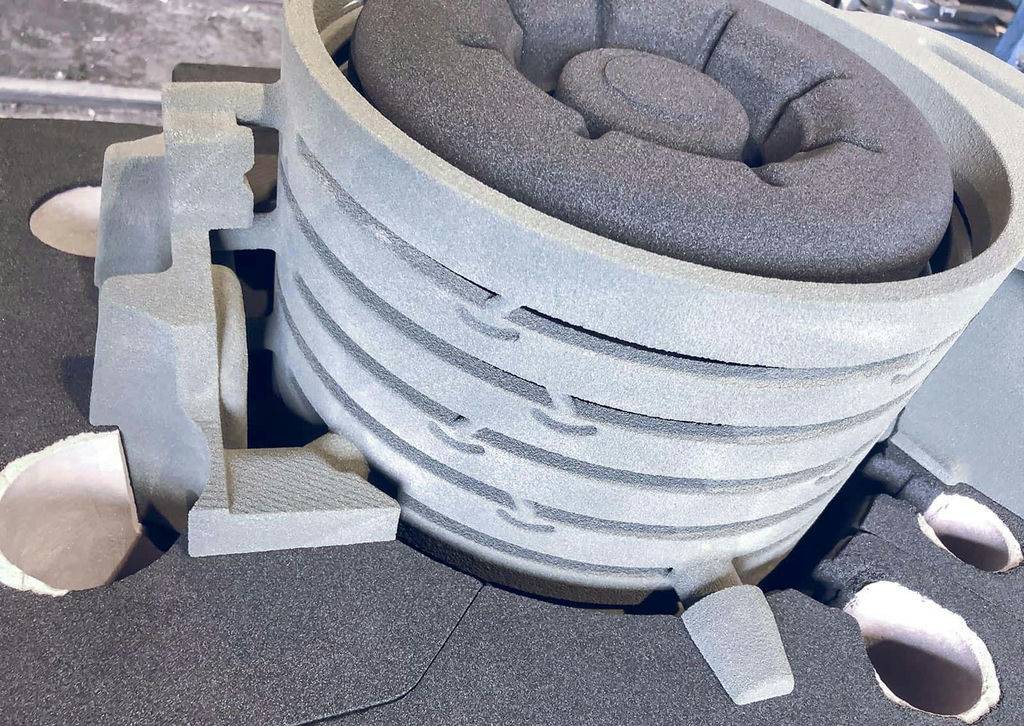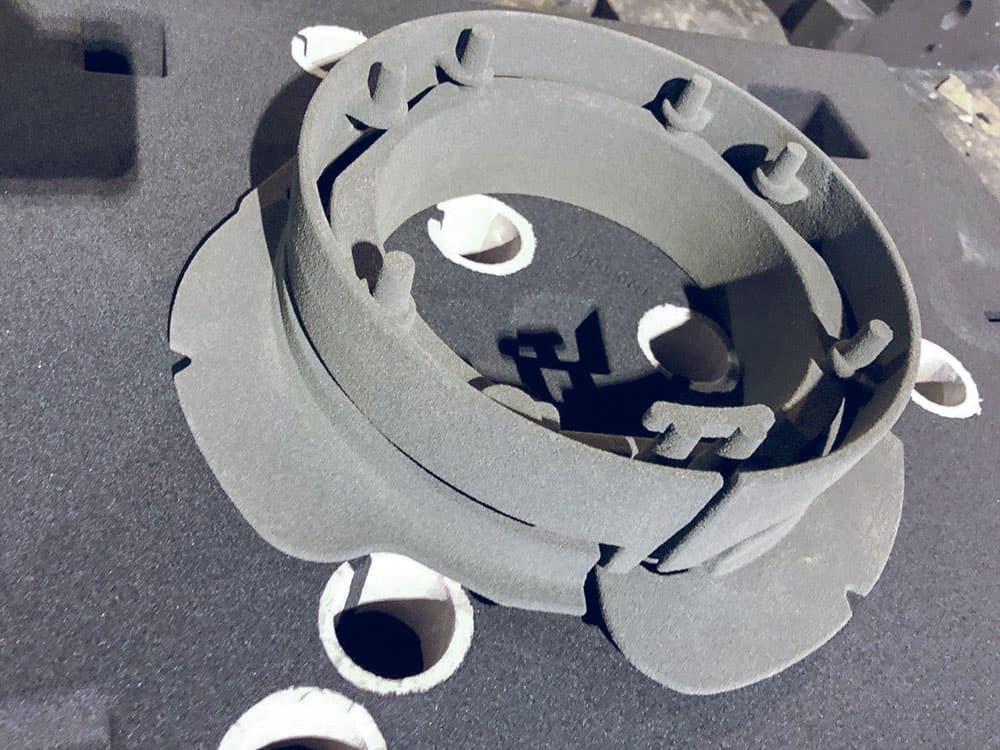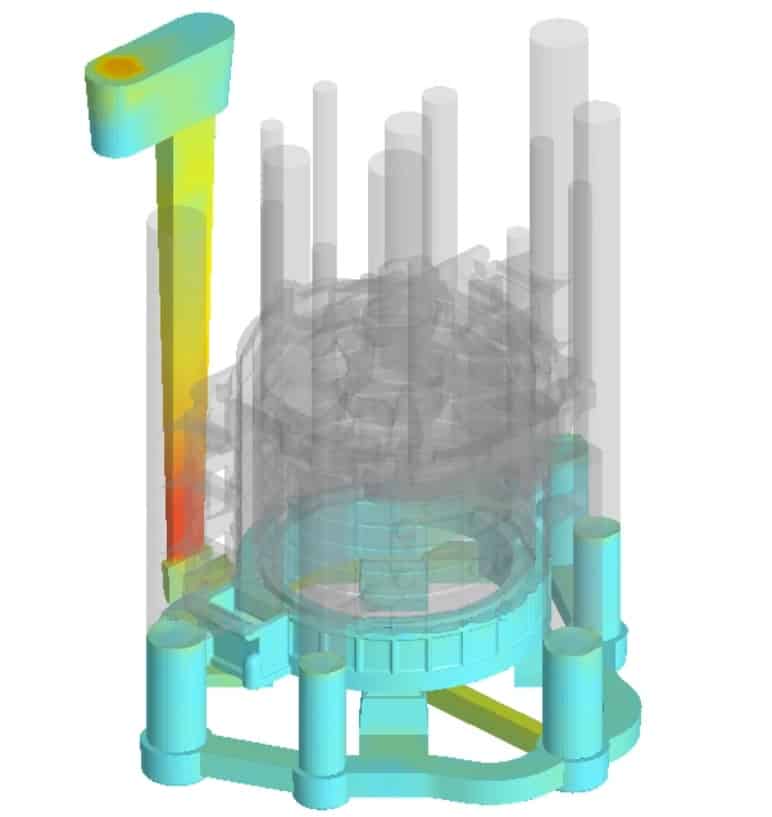British company Brooks Crownhill Limited (BCP) utilizes 3D sand printing from voxeljet for production of housings for electric motors and automotive parts. BCP has prototypes produces using 3D sand printing well before they are ready for series production. The advantage: the ability to design highly complex parts without having to keep expensive tools on hand. The reason for this is that rapid prototyping allows end users to thoroughly inspect and extensively test the newly designed components before the production tools are manufactured. This saves a massive amount of time and money.
Molds made of sand are relatively cost-effective and sufficiently refractory for the application in steel and, above all, aluminum foundries. For this reason, casting with sand molds continues to enjoy great popularity, especially in the automotive industry. Modern industrial 3D printing has opened up completely new possibilities for foundries, since with the help of 3D printing systems, such as the binder jetting systems from voxeljet, even highly complex molds and cores can be manufactured. Over 60 percent of all metal castings are produced by sand casting.
Lee Henderson, Sales Director at Brooks Crownhill, comments on the collaboration with voxeljet: “We have been using 3D printing and casting, or printed casting, for quite some time now. The immense advantages are obvious. The process is fast, cost-effective and gives designers enormous creative freedom. This is important for rethinking established components and saving as much material as possible, for example by optimizing the topology of the components.” BCP largely manufactures engine components and, more recently, housing components for electric motors for its customers in the automotive sector. “We have to make our parts lighter and lighter. And we need to do this while maintaining, or even better, increasing load-bearing capacity and extending the service life of the parts. This is where voxeljet comes to our aid with its 3D sand printing.”
So-called lightweight design is one of the most important design trends of recent years. Customer designs are being pushed further and further to the limits of manufacturability: thinner wall sections of the entire casting and higher tolerance bands for positional accuracy. “3D sand printing is therefore irreplaceable. Not only because it allows us to realize geometries that would not be possible using conventional processes such as milling or core shooting, but especially when we want to test brand new designs, we need the optimized prototypes quickly. We then take a close look at these with specific integrity tests (NDT, Non-Destructive Testing) before we give the go-ahead for series production,” says Sales Director Henderson.
“In modern engineering, 3D printing means above all that we can print complex inner cores as one part. This saves us a lot of work in casting preparation. And we can be confident that all tolerances on wall thickness and the associated stability of the cores will be maintained during the enormous stresses of metal casting,” says Henderson. “Further economic opportunities are opened up by time-saving printed castings when you reduce potential costs and conventional assembly time on complex core-stack assemblies line-side. This has a direct impact on the business model, ongoing costs and delivery times to the customer.”
However, Henderson also notes that the benefits of additive manufacturing of molds and cores are not yet one hundred percent clear in the minds of engineers. “3D printing, unfortunately, still has a niche existence. It is increasingly recognized within the foundry industry as a fully-fledged manufacturing process for casting molds, but I’m not sure to what extent the advantages are even known by both engineers and also the key buyers. There are still unimagined design and cost opportunities that could be leveraged here.”
Greater latitude in the design of 3D printed sand molds is closing the gap between “design for manufacturing” and “design for functionality”. Casting expert Henderson: “Today, engineers can use finite element analysis (FEM) to optimize functionality and then directly 3D print the designs. This makes the design of engine parts, for example, a lot faster and, more importantly, the components are stronger, which in turn allows drastic weight reductions. This is extremely attractive, especially in the wake of current environmental regulations such as lightweight construction, and the associated energy savings.”
3D Printing offers more than mere product optimization
But the advantages do not stop there. “With 3D printing, we can plan gas channels into the sand cores and molds during the design stage. These are used for venting and outgassing during the casting process, making our job much easier, and has a great effect on the quality of the cast parts, in terms of density and surface quality” Henderson explains. ” Adding structural tie rods for better transportability of the parts is also possible and simplifies the handling of the printed parts.”
BCP also relies on the use of different sand systems for each application. For example, high-strength and high-temperature cores to ensure stability and concentricity of the inner cores during the casting process of high temperature alloys.
The binder jetting process for printed castings: This is how it works!
The 3D printing system spreads a 300 micrometer thin layer of sand on to the building platform. The print head then uses a binder to bond the sand grains together wherever the casting mold is to be created. The build platform lowers by one layer thickness and the process starts again until the mold is completed. The excess sand is then removed, and the mold is ready for casting. The printed molds and cores can also be combined with simple, conventionally produced casting molds at any time.
 Image 1 – The core for the electric engine housing is optimized for a more efficient cooling of the engine and was printed with special ceramic sands that ensure stability precise tolerances during metal casting.
Image 1 – The core for the electric engine housing is optimized for a more efficient cooling of the engine and was printed with special ceramic sands that ensure stability precise tolerances during metal casting.
 Image 2 – 3D printed cores can be combined with conventional manufactured molds to ensure a high degree of cost effectiveness.
Image 2 – 3D printed cores can be combined with conventional manufactured molds to ensure a high degree of cost effectiveness.
 Image 3 – With casting simulation the behavior of the molds and cores can be tested before the actual casting. If the simulations show any possible threats, cores and molds can be digitally optimized before printing to ensure an ideal casting process.
Image 3 – With casting simulation the behavior of the molds and cores can be tested before the actual casting. If the simulations show any possible threats, cores and molds can be digitally optimized before printing to ensure an ideal casting process.

Image 4 – The VX1000 from voxeljet is capable of additive manufacturing of molds and cores with sizes up to 1,000x600x500 mm. It can either work with furanic or phenolic resin to maximize the flexibility and choice of sand materials for metal casting.

